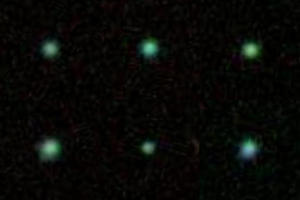"The green peas are compact galaxies where stars are formed at a high rate and they are very similar to the galaxies that were common in the early universe" says Jescott. "The analysis we conducted shows that it is possible that ionizing radiation is leaking from them."

Galaxies shaped like green peas discovered by amateur astronomers in 2007 could help astronomers understand reionization, a key step in the evolution of the early universe. That's what researchers from the University of Michigan say.
Reionization occurred a few hundred million years after the Big Bang when the first stars ignited and formed the first galaxies. During this time, the intergalactic space changed from a thick but neutral nebula to a transparent, ionized plasma, as we see it today. (Plasma is an electrically charged gas.)
As for how the change occurred, the common theory holds that massive stars in the early galaxies produced an abundance of ultraviolet light that escaped into intergalactic space. The ultraviolet radiation reacted with the neutral hydrogen gas in intergalactic space, knocking electrons off the hydrogen atoms and leaving a plasma with negatively charged electrons and positively charged hydrogen ions.
"We believe that this is what happened, but when we look at nearby galaxies, the high-energy radiation does not seem to be enough. We have to find some galaxies where radiation escape occurs" says Anne Jescot, PhD student in astronomy.
Jescott and Sally Ewe, a professor of astronomy in the College of Arts, Sciences and Letters at the University of Michigan, found that the green peas could provide that evidence. Their findings were published in the April 3 issue of the Astrophysical Journal.
"The green peas are compact galaxies where stars are formed at a high rate and they are very similar to the galaxies that were common in the early universe" says Jescott. "The analysis we conducted shows that it is possible that ionizing radiation is leaking from them."
The researchers focused on the six galaxies of this type where the rate of star formation is the highest, and which are 1-5 billion light years away from us. They studied their emission lines as observed by the Sloan Digital Sky Scanner. The emission lines show how light interacts with matter and in this case, they help astronomers understand the connections between the stars and the gas in these galaxies."
The emission lines tell Jescott and Levi how much light the galaxies are absorbing, and then to determine how much radiation they started with, they ran a model to estimate, for example, the age of the galaxies and the number of stars they contain. According to the estimates - the galaxies produce more radiation than the researchers discovered, so it is clear that some of it had to escape."
"An analogy for this can be seen when you pour liquid on a tablecloth. If you see a stain that continues to the end of the map, it is most likely that something fell on the floor as well." Jescott says. "We see the gas like a map and see how much light the galaxy absorbs. It absorbs a lot of light, we see that the galaxy is saturated with light and there is a chance that some of the light also leaked from the edges."
According to her, the green peas are good candidates to help astronomers understand the main milestones in the evolution of the universe 13 billion years ago.
The research was funded by the National Science Foundation.

4 תגובות
Mirom
It is clear to you that if we are dealing with galaxies so far away, 1-5 billion light years away, there is no chance that such distant radiation will begin to tickle our solar system, and in the meantime, no manned spacecraft (Epi' with a monkey) has crossed our solar system, so that in the visible range there is no chance of damage to health to something or someone human by them
If ionizing radiation is leaking from them, at what distance is it recommended to be from the galaxies so that they do not harm our health?